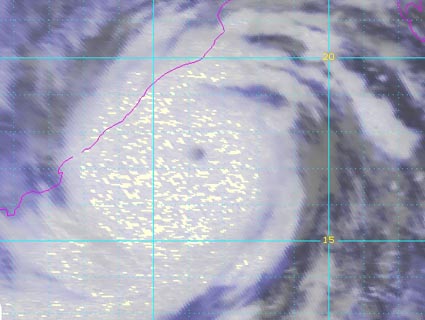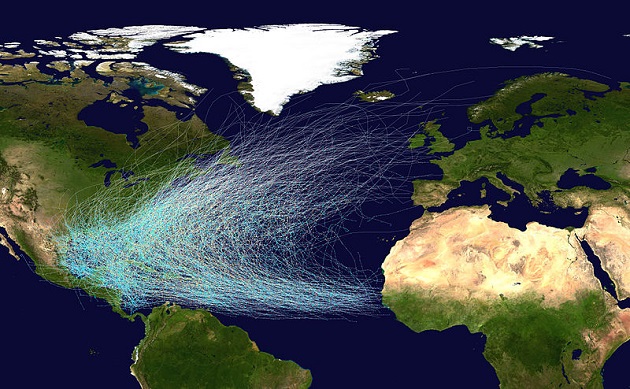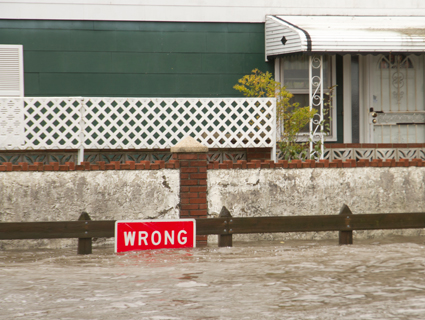
<a href="http://www.ssd.noaa.gov/PS/TROP/floaters/02B/02B_floater.html">NOAA</a>

UPDATE 10:45 a.m. PT, Sunday, October 13, 2013: According to CNN, in India’s Odisha state, which was battered this weekend by Cyclone Phailin, “at least 13 people were killed after trees fell and walls collapsed when the storm hit, Police Chief Prakash Mishra said. Another death was confirmed in Andhra Pradesh state, India’s disaster management authority said. Many had feared the death toll would be higher. Massive evacuation efforts helped limit the number of casualties, officials said.”
UPDATE 7:30 p.m. PT, Saturday, October 12, 2013: Cyclone Phailin made landfall on Saturday night around 9 pm local time, according to the Times of India. “Broken glass pieces, wood shreds and asbestos sheets flew like killer projectiles in the adjoining cities of Gopalpur and Berhampur,” the Times reported. An estimated 12 million people were in the storm’s path by the time it made landfall, with wind speeds around the predicted 130 miles per hour. 18 fishermen were stuck at sea when the cyclone hit, according to the Times. As the sun rises in India Sunday morning, the country will begin assessing the damage.
By Saturday afternoon, a massive cyclone currently traveling across the Bay of Bengal is expected to hit the coast of India. The government has evacuated more than a quarter million people to prepare for the storm, named Cyclone Phailin (pronounced: phie-lin), which it expects to cause massive power outages, floods, and damage to homes in the region. Here are some facts on the storm, and what’s ahead:
How bad is this storm?
The India Meteorological Department describes Phailin as a “very severe” storm, and the National Center for Atmospheric research rates it as a Category 5. It’s expected to hit the coast with winds up to 137 miles per hour, 9.8 or more inches of rain, and storm surges up to 11.5 feet. For reference, the storm surge in the Battery in New York City during Superstorm Sandy peaked at 9.2 feet, and the surge in nearby Kings Point, NY was 12.7 feet according to the Weather Channel. The India Meteorological Department predicts “extensive damage” to houses made from hay and mud, which are common in the region, as well as flooding, power outages, traffic disruption, and “the flooding of escape routes” in areas affected by the cyclone.
Writing at Quartz, meteorologist Eric Holthaus thinks that Cyclone Phailin could be more damaging than current estimates (emphasis added):
At one point (2 am Friday, India time), one satellite-based measure of Phailin’s strength estimated the storm’s central pressure at 910.2 millibars, with sustained winds of 175 mph (280 kph). If those numbers were verified by official forecast agencies, they would place Phailin on par with 2005′s Hurricane Katrina, and break the record for the most intense cyclone in Indian Ocean recorded history.
To get a sense of the size of the storm, this satellite image from the University of Wisconsin shows the cyclone, which appears to be about half the size of India.
Where is it heading?
Cyclone Phailin will primarily hit two states on the eastern coast of India, Odisha and Andhra Pradesh, and is expected to cause heavy rainfalls in a third, West Bengal. Low-lying areas near the coast, which is dotted with small fishing towns, are expected to be damaged by the storm surge. Reuters reports that the Indian government has made an effort to evacuate people, though not all of them are willing to leave:
Some 260,000 people were moved to safer ground and more were expected to be evacuated by the end of the day, authorities in the two states said. Not everybody was willing to leave their homes and belongings, and some villagers on the palm-fringed Andhra Pradesh coast said they had not been told to evacuate.
“Of course I’m scared, but where will I move with my family?” asked Kuramayya, 38, a fisherman from the village of Bandharuvanipeta, close to where the hurricane is expected to make to landfall, while 3.5-metre (12-foot waves) crashed behind him. “We can’t leave our boats behind.”
What’s the difference between a cyclone and a hurricane?
There isn’t one. Hurricanes, cyclones, and typhoons are all the same weather phenomenon, but they have different names depending on where they occur. (This National Geographic article has a complete breakdown of storm names by region.)
Do cyclones hit India often?
Bangladesh and the eastern coast of India have a history of devastating cyclones. According to Weather Underground‘s history of cyclones in the region, “most of the deadliest tropical storms on earth have occurred in the Bay of Bengal when tremendous storm surges have swamped the low-lying coastal regions of Bangladesh, India, and Burma.” Of Weather Underground‘s list of the 35 deadliest storms on record, 26 of them occurred in the Bay of Bengal.
As cyclone Phailin heads towards land, the Hindu Times reports that many people are recalling the massive Cyclone 05B, often referred to as the Odisha cyclone, that hit the area in 1999 and killed nearly 10,000 people.






